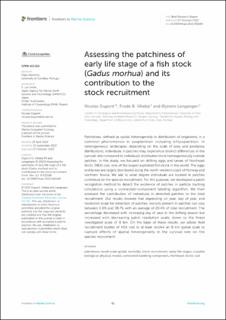Assessing the patchiness of early life stage of a fish stock (Gadus morhua) and its contribution to the stock recruitment
Peer reviewed, Journal article
Published version
Permanent lenke
https://hdl.handle.net/11250/3035364Utgivelsesdato
2022Metadata
Vis full innførselSamlinger
- Articles [3012]
- Publikasjoner fra CRIStin [3070]
Sammendrag
Patchiness, defined as spatial heterogeneity in distribution of organisms, is a common phenomenon in zooplankton including ichtyoplankton. In heterogeneous landscapes, depending on the scale of prey and predatory distributions, individuals in patches may experience distinct differences in the survival rate compared to individuals distributed more homogeneously outside patches. In this study, we focused on drifting eggs and larvae of Northeast Arctic (NEA) cod, one of the largest exploited fish stock in the world. The eggs and larvae are largely distributed along the north-western coast of Norway and northern Russia. We ask to what degree individuals are located in patches contribute to the species recruitment. For this purpose, we developed a patch recognition method to detect the existence of patches in particle tracking simulations using a connected-component labeling algorithm. We then assessed the contribution of individuals in detected patches to the total recruitment. Our results showed that depending on year, day of year, and resolution scale for detection of patches, recruits present in patches can vary between 0.6% and 38.7% with an average of 20.4% of total recruitment. The percentage decreased with increasing day of year in the drifting season but increased with decreasing patch resolution scale, down to the finest investigated scale of 8 km. On the basis of these results, we advise field recruitment studies of NEA cod to at least resolve an 8-km spatial scale to capture effects of spatial heterogeneity in the survival rate on the species recruitment.
